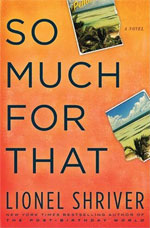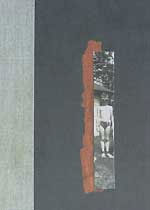
Lionel Shriver’s So Much For That is a jolting experience, but it’s not a rollercoaster ride. That would suggest moments of ascent and exhilaration as well as gut wrenching downward spirals. So Much For That is more a steady descent into hell for two middle class American families: comparatively modestly living their lives, contending with some challenges, experiencing personal and professional triumphs, making some mistakes and errors in judgement along the way, but nothing that would seemingly warrant the misery that Shriver visits upon them.
What reader would perversely stick around for such a dismal journey, one that dredges up the worst case scenario catastrophes lurking beneath and waiting to be unleashed by everyday occurrences that start out benignly enough: a doctor’s appointment, a credit card debt that is starting to get a bit out of hand, an elderly but still independent parent taking a tumble, a reprimand from a perhaps unreasonable boss about some late office arrivals …? The reader learns quickly that Shriver doesn’t shy away from a single humiliating detail of those situations run tragically amuck, no matter how intimate or grim it gets. Just as quickly, the reader comes to trust Shriver’s laser precise honesty and the fundamental clarity with which she imbues or finally bestows on her central characters (peripheral characters, not so much – they’re irritating foils, albeit rendered with razor sharp wit). That potent, acerbic honesty means you won’t look away either, no matter how much those scenarios are your own worst nightmares. As unflinching as Shriver is delineating each character’s folly, self-absorption, selfishness or delusion, she is equally generous showing their resilience, courage and tenderness. The result is a story populated with believable, not always likeable or lovable, fully dimensional characters tackling real situations that might still illustrate our own worst fears, but inspire us to approach them with the same ultimate grace. Still, is patriarch Shepherd too much a literal rendering of his own name, and perhaps an unrealistic modern Job? After the ragged, searing twists, turns and injustices throughout the novel, is the ending just a bit too neatly sewn up? Perhaps, but after the rough ride Shriver takes her characters and readers on, the ending feels reasonable, compassionate and earned, as Shep captures in a moving and candid moment with his terminally ill and finally fiercely undeluded wife:“You know, these movies …” He was groping. “Remember how sometimes, in the middle, a movie seems to drag? I get restless, and take a leak, or go for popcorn. But sometimes, the last part, it heats up, and then right before the credits one of us starts to cry – well, then you forget about the crummy middle, don’t you? You don’t care about the fact that it started slow, or had some plot twist along the way that didn’t scan. Because it moved you, because it finally pulled together, you think, when you walk out, that it was a good movie, and you’re glad you went, See, Gnu?” he promised. “We can still end well.”




